By Jackie Clay-Atkinson
With grocery store milk prices climbing up to more than $4 a gallon, a lot of folks wish they had a milk cow. But cows require a large pasture and substantial barn. They also eat a lot, which means buying large amounts of hay and grain throughout the year. Then there’s the problem of getting them bred every year. Artificial insemination is definitely possible, but timing and even noticing your cow’s heat period is often challenging, resulting in a cow that doesn’t get bred. And hauling the cow to visit a bull requires a trailer and experience getting the cow into the trailer. No wonder so few homesteaders have cows!
But you still really want your own milk, yogurt, ice cream, cheese, and cottage cheese. The easy answer is choosing a dairy goat instead of a dairy cow. Worldwide, there are more dairy goats than dairy cows, as it has been for centuries.
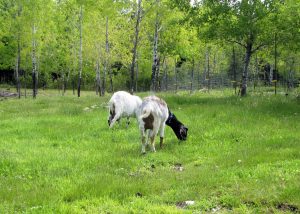
Here’s our two-acre goat pasture with grasses, clover, and plenty of shade.
Dairy goats are rather small, most weighing about 100 pounds or so. They are easy to handle, as you can lead them around by a collar, just like a dog. If they step on your foot, it’s no big deal. Being small, they are easy to house. A goat is quite comfortable in a stall in the corner of an 8 x 12-foot shed; they don’t need a barn. Because of their small size, they need much less hay, pasture, and grain than a cow. A bale of hay will last a dairy goat a week if it is of decent size and quality.
Also, getting the doe (female) to the buck (male) is simple. Most folks just put the doe in the back seat of the car or in a camper shell of their pickup. With a little grain, a goat will follow you most anywhere.
Fencing
Fencing is a little more challenging, however. Of all the farm animals, goats are among the hardest to securely fence in. Rather than jump over the fence, they sort of lean through, pulling regular woven wire stock fencing down in a short time. Electric fencing does not work for long; goats soon learn when the fence has been shorted out by long grass or a branch blowing down on it.
But you certainly can fence goats in to stay. Our corrals are solid welded stock panels, 16 feet long and about 52 inches tall. The large pasture has stock panels around the most challenging spots: the gate and next to the garden. The rest is made up of woven wire field fencing with two strands of electric wire on stand-off plastic insulators on the inside of the fence. This keeps the goats from stepping up on the fencing squares to look around and from leaning through the fence to reach grass on the outside of the fence.
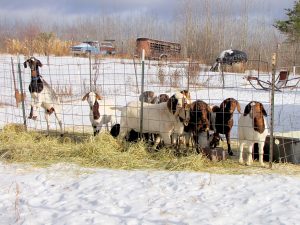
Our dairy goats in Northern Minnesota have access to the outside all winter. Note the stock panel fencing of the corral which holds goats securely in.
As we are off grid, we power the fence with a 12-volt, battery-operated, electric fence from Parmak. There are lighter, cheaper fences but they don’t put out much of a jolt and the goats soon short out the fence; been there; done that.
Milk
How much milk does a dairy goat give? Most good dairy goats produce at least a gallon a day. That’s enough milk for drinking and to give you some experience in making delectable dairy products such as your own yogurt and cheeses.
But doesn’t goat milk taste funny? No it doesn’t; you can’t tell goat milk from cow milk. I’ve proven that time and time again to folks who thought goat milk tasted like a goat. The only difference is that goat milk is naturally homogenized and the cream will not settle at the top as does cow’s milk, making collecting cream difficult without a cream separator. But other than that, the two milks are very similar.
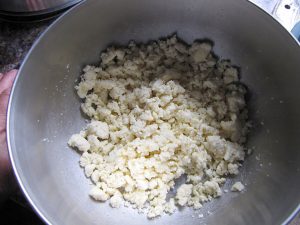
With your own dairy goat, having fresh milk and dairy products like this cottage cheese can be a daily event.
Choosing your goat
Choosing your dairy goat is much like choosing a car; a lot depends on personal preference. There are five major breeds of dairy goat: Alpine, Oberhasli, Saanen, Toggenburg and Nubian.
Alpines are a medium-large goat with erect ears, coming in a variety of colors, chiefly black and white. The udder is large and they are excellent milkers of good disposition.
Oberhaslis are a Swiss breed with erect ears, having a reddish coloration with black points. They are less common than Alpines but are gaining popularity as they are excellent milk goats.
Saanens are one of the largest of the dairy breeds and also the most common. You’ll easily spot them as they are pure white with erect ears. They are wonderful producers and usually have mellow dispositions.
Toggenburgs are a large breed with erect ears. They have a brown coat with white stripes on their face and lower legs. Toggs are excellent milkers with a mild disposition. One currently holds the world record for goat milk production, producing 1,140 gallons of milk in 365 days!
Nubians are an African breed and are prized not only for their excellent milk production but also for their long, floppy ears and stunning colors. Nubians can be any color from black to white, and spots are very common.
Choose a breed that you like, just as you would a car. There is no “best” breed. But I’d advise getting a goat from a breeder rather than an auction or some other dubious place. That way, you can see the goat in her home, be able to milk her, and see her mother and sire. Registration papers are not necessary for a homestead milking doe, but knowing her ancestors is a great help. As the old saying goes: An apple doesn’t fall far from the tree.
A good doe’s udder should resemble a basketball — round and full, with slender, fairly long teats pointed down or slightly forward. You do not want a doe with bulbous or extremely long teats. She will be prone to developing mastitis (infection of the udder) and that will reduce her longevity for milk production.
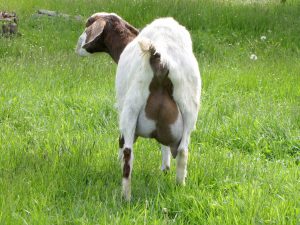
A good dairy goat should have an udder like a basketball with nice, slender teats projecting downward or slightly forward.
I firmly believe that a dairy goat should not have horns. You can easily and effectively disbud a kid soon after birth so that they never grow horns. While goats will not butt you with their horns, they can become entangled in fences, strangle in their own collars, or hurt you by accident with horns. Horns are not necessary and are dangerous to both the goat and the people handling them. Please buy a hornless goat and learn to disbud your kids.
Your first goat should have a friendly disposition and should not appear to be afraid of people. With experience, you will be able to “tame” down a doe that is frightened because she has not been handled. But at first, choose a “pet” type goat that loves you.
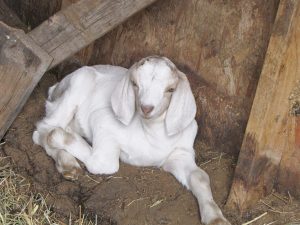
A cute white and tan Nubian doeling — note the long, floppy ears.
Care of your goat
During the summer, goats do well on good pasture containing grass and legumes such as clover. Don’t expect good milk production if her pasture consists of brush and weeds! Fence that pasture. Don’t tie the goat out on a chain or rope. I can’t tell you how many tragic accidents have befallen staked-out goats, either from predators or from becoming tangled in their chain and strangling.
Fresh water is essential. If a goat poops in their water, they will often refuse to drink it and can quickly become dehydrated.
Likewise, shade is necessary. Swiss goats, such as Alpines and Toggenburgs, can quickly become overcome by the heat with scanty shade. You can provide shade with large trees in the pasture or a shelter.
Goats need grain twice a day to thrive unless they have excellent pasture and are not growing kids or milking does. We feed our goats a sweet feed with a 16% protein content. Be sure your feed does not contain urea as this is poisonous to goats! Many dairy cow feeds contain urea as it’s a cheap source of protein.
Your goats should be fed as much grain as it takes to keep them shiny and looking good. We feed our heavy milkers a 3# coffee can full of feed at each milking; a bit more if they have a thinner body type.
During the winter, goats do well in any draft-free enclosed shelter. Even here in Northern Minnesota, we let our goats freely go in and out, as weather permits and if they choose, locking them in at night.
For ease of milking, it’s best to milk your doe on a milking stand. She can easily hop up onto the table part of the stand, about 18 to 20 inches from the ground. Her head goes through an adjustable stanchion to her feed in a box outside the stanchion where she eats while the stanchion is closed to keep her securely in place. The milking stand is also a good place to trim her feet or give veterinary care, if necessary.
Resources
I hope you’ll really consider adding a dairy goat to your homestead. I’ve had them for more than 50 years and can’t imagine life without them. Here are a few sources of more information to help you decide.
BOOKS:
Storey’s Guide to Raising Dairy Goats
By Jerry Belanger and Sara Thomson Bredesen
Dairy Goats: A beginner’s handbook
By Jackie Clay (Available through Backwoods Home Magazine)
SUPPLIES:
Hoegger Supply Company
200 Providence Rd.
Fayetteville, GA, 30215
800-221-4628
hoeggerfarmyard.com
Caprine Supply
P. O. Box Y
De Soto, KS 66018
800-646-7736
www.caprinesupply.com

